Aging in place offers comfort, familiarity, and independence but staying safe at home often requires a few thoughtful changes. You don’t need a complete remodel to make your space easier to navigate and live in. With small updates and smart adjustments, you can reduce risks and create a home that supports mobility, comfort, and peace of mind well into the future. It all starts with making your surroundings work better for you.
Install Grab Bars and Reinforce Stability
Falls are one of the most common risks for older adults, especially in bathrooms and entryways. Installing grab bars in key areas like next to toilets, inside showers, and near bathtubs can dramatically improve safety. These bars offer extra support when sitting, standing, or navigating slippery surfaces, and they’re available in stylish designs that blend into your décor.
For added stability, make sure railings on stairs are secure and easy to grip. Consider non-slip mats or adhesive strips for steps and bathroom floors. Small additions like these reduce the chances of a fall and provide confidence when moving through the home. Stability-focused upgrades may be small, but they make a major impact.
Clear Pathways and Reduce Clutter
Excess clutter creates obstacles that increase the risk of trips and falls. Start by clearing walkways, especially in high-traffic areas like hallways, kitchens, and bedrooms. Remove unnecessary furniture, loose rugs, and anything stored on the floor. A clean, open space makes it easier to move safely, especially with a cane, walker, or mobility aid.
Use furniture with rounded edges and keep cords neatly tucked away. Try organizing items you use regularly at waist level so you don’t have to reach or bend as often. Even a few hours spent decluttering can transform your home into a safer, more accessible space—without spending a dime.
Improve Lighting Throughout Your Home
Proper lighting is essential for safe movement. Dim or uneven lighting can make it hard to spot steps, edges, or tripping hazards. Increase brightness by using higher-wattage bulbs and adding lamps or wall lights in areas that feel shadowy. Focus especially on stairways, entrances, hallways, and bathrooms.
Motion-sensor lights are a great addition for nighttime trips to the bathroom or kitchen. Place nightlights in bedrooms and along key walking paths to maintain visibility after dark. Good lighting isn’t just about visibility—it also helps prevent eye strain and supports better sleep cycles by reinforcing natural daily rhythms.
Make Everyday Tasks Easier
Simple adjustments to furniture and tools can make everyday living much more comfortable. Consider using lever-style door handles and faucet knobs, which are easier to grip than traditional round designs. Add a reacher grabber tool or extendable duster to help you access high or low areas without strain.
Place frequently used items—like medications, utensils, or clothing—within easy reach to minimize the need for bending or stretching. Use slip-resistant mats under kitchen and bathroom rugs, and swap heavy cookware or dishes for lighter alternatives. These subtle changes reduce physical strain while helping you maintain your independence at home.
Create a Comfortable, Functional Layout
Your home should work with your daily routines, not against them. Rearranging furniture to allow wider, clearer walkways can make a big difference in how easily you move from room to room. Keep seating sturdy and at a height that’s easy to get in and out of. If you use mobility aids, make sure they fit easily through doorways and around corners.
In the kitchen, bathroom, and bedroom, think about how your space functions during your daily activities. Adding a chair to your bathroom or a small bench by your front door can create resting spots that support your comfort. Adapting your layout makes your home feel more livable without any major construction.
A Home That Supports You at Every Stage
Aging in place isn’t just about staying in your home—it’s about creating a space that grows with you. Small, thoughtful changes can reduce risks and help you move through your day with more ease and confidence. From grab bars and lighting to layout and organization, your home can support your independence every step of the way. When safety and comfort go hand in hand, staying at home becomes not just possible, but enjoyable.

